The Importance of Route Optimization
Before diving into the intricacies of addressing constraints and preferences in route optimization, let’s explore the importance of this process. In today’s ever-evolving landscape, businesses rely heavily on efficient transportation and delivery systems.
Companies must ensure timely and cost-effective deliveries to maintain a competitive edge and satisfy customer demands. Route optimization not only benefits businesses but also has significant environmental implications. By finding the most efficient routes, the transportation industry can reduce fuel consumption and emissions, contributing to a more sustainable and eco-friendly environment.
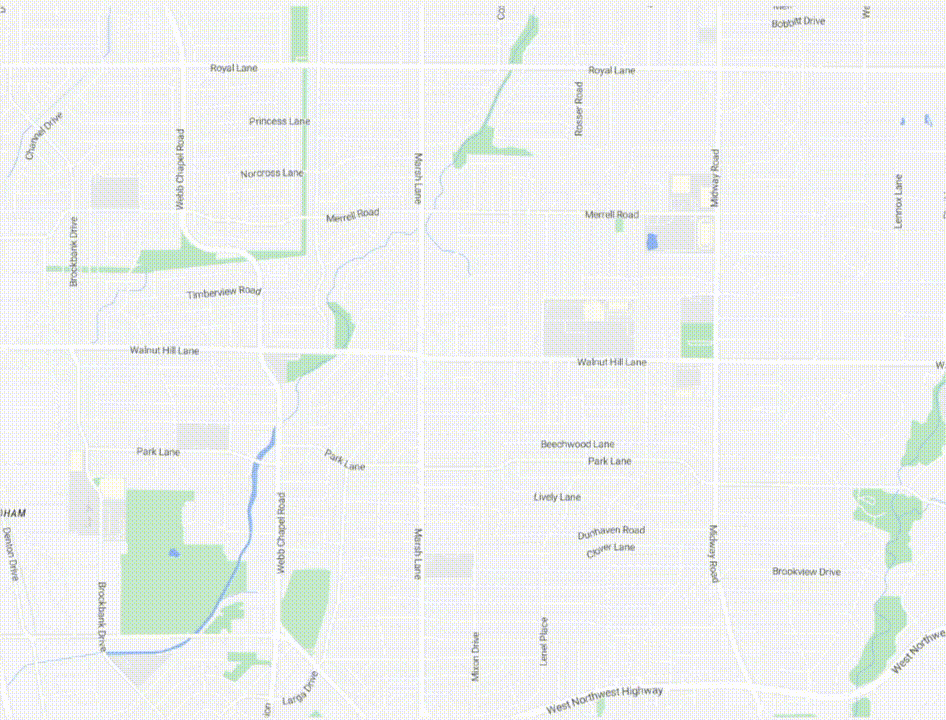

Constraints in Route Optimization
One of the primary challenges in route optimization is dealing with various constraints that arise from real-world scenarios. These constraints can significantly impact the efficiency of routes and require careful consideration during the optimization process. Some common constraints include:
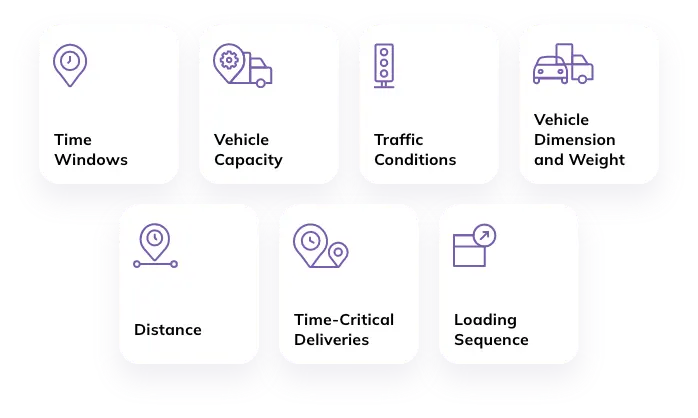
Before diving into the intricacies of addressing constraints and preferences in route optimization, let’s explore the importance of this process. In today’s ever-evolving landscape, businesses rely heavily on efficient transportation and delivery systems.
Companies must ensure timely and cost-effective deliveries to maintain a competitive edge and satisfy customer demands. Route optimization not only benefits businesses but also has significant environmental implications. By finding the most efficient routes, the transportation industry can reduce fuel consumption and emissions, contributing to a more sustainable and eco-friendly environment.
Time Windows
Certain delivery locations or service appointments may have specific time windows during which they can be visited. For example, a courier service might need to deliver packages to a customer’s home between 9:00 AM and 5:00 PM. Ignoring these time windows can result in missed deliveries and dissatisfied customers.
Vehicle Capacity
In transportation and logistics, vehicles have limited capacities in terms of weight or volume. Optimized routes should ensure that the total load carried by each vehicle does not exceed its capacity to avoid potential accidents or overloading.
Traffic Conditions
Real-time traffic data is essential in route optimization to avoid congested areas and minimize travel delays. Routes should be adjusted dynamically based on current traffic conditions, ensuring efficient movement through the road network.
Vehicle Dimension and Weight
Certain roads may have restrictions for specific vehicles, such as weight limits on bridges or height restrictions in tunnels. These constraints must be taken into account to avoid unnecessary detours or potential violations.
Distance
Optimized routes balance a vehicle's travel distance with associated costs like fuel, tolls and maintenance. Both physical travel capacity and financial considerations play a role in efficient route planning.
Time-Critical Deliveries
Perishable items have a limited window of freshness, compelling deliveries to occur within specific timeframes. Optimization strategies must ensure that routes prioritize timely arrivals at destinations to prevent spoilage.
Loading Sequence
The strategic arrangement of items during loading plays a critical role in diverse scenarios such as temperature-controlled transportation, employee commuting and other delivery needs. Route optimization must factor in loading orders based on specific criteria, such as temperature needs, employee preferences or specific delivery considerations.
The Complete Guide to Route Optimization
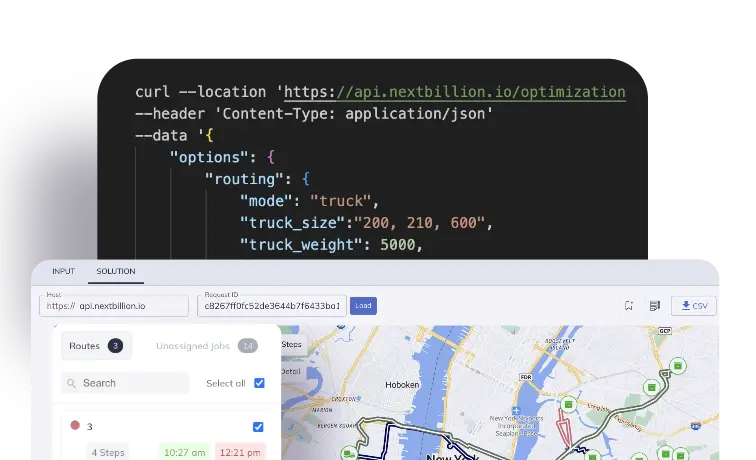
Incorporating Preferences in Route Optimization
While addressing constraints is vital, taking into account individual preferences can further enhance the effectiveness of route optimization. Preferences can be diverse, depending on the specific use case, and they may include:
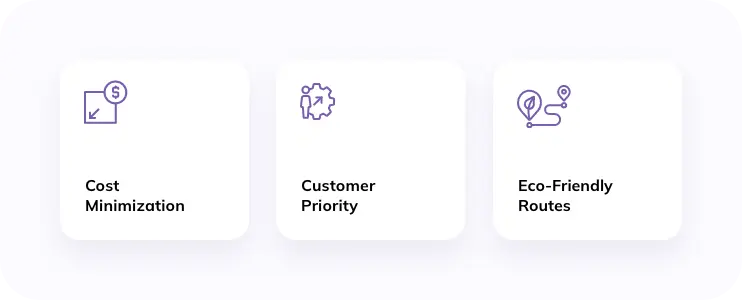
Cost Minimization
Many businesses prioritize cost reduction in their operations. In route optimization, the objective could be to minimize expenses related to fuel, tolls, labor, or vehicle maintenance.
Customer Priority
Certain customers or locations may be more critical than others, and they could be assigned higher priorities during route optimization. This ensures that important deliveries or service appointments are given precedence.
Eco-Friendly Routes
With an increasing focus on environmental sustainability, some businesses aim to minimize their carbon footprint. Eco-friendly route optimization involves choosing paths that have lower emissions and reduce the impact on the environment.
Capabilities of NextBillion.ai Route Optimization API
Discover the diverse capabilities of the NextBillion.ai Route Optimization API as we explore a comprehensive list of optimization objectives, constraints, and features it offers to empower your routing solutions.

Important Optimization Preferences
Travel Cost
The travel cost objective attribute is a crucial component for configuring optimization tasks. It helps businesses fine-tune their optimization strategies based on specific priorities. By adjusting the 'travel cost' parameter, you can guide the optimization engine to minimize either the distance traveled by vehicles, the time taken to complete tasks or even consider the air distance for unique cases like drone deliveries. Setting the parameter to 'customized' offers a personalized approach, allowing you to provide custom cost values using the cost matrix attribute.
Traffic
The 'traffic timestamp' attribute allows you to set the preferred time for task execution. By factoring in traffic conditions at that time, the solver optimizes routes and estimated arrival times, helping businesses make informed decisions for efficient routing.
Departure Time
The ‘departure time’ constraint returns a route aligned with typical traffic conditions at the specified start time. This parameter enhances route accuracy by considering traffic conditions during planning, contributing to more reliable travel estimates.
Standard Constraints
Skills
The ‘skills’ parameter, present in jobs, shipments and vehicles, allows businesses to define the expertise and capabilities required for efficient task execution. It ensures that only vehicles, workers and drivers equipped with the complete set of skills required for a specific job or shipment are assigned to that task. For example, the skills constraint ensures that only vehicles equipped with temperature-controlled compartments and drivers skilled in carrying heavy boxes will be exclusively assigned for transporting temperature-sensitive pharmaceuticals.
Pick-up and Delivery
Whether it's shipments or jobs, the 'delivery' attribute comes in handy when tasks involve delivering items. This attribute allows you to specify the quantity of items being delivered, accommodating different units or sizes for more versatile handling. Similarly, when tasks entail picking up items, the 'pickup' attribute serves the purpose of defining the quantity of items to be collected. Shipments encompass both pickup and delivery as a complete package, while jobs represent individual tasks, either pickups or deliveries.
Time Window
The 'time window' constraint is a versatile element that finds its place in jobs, shipments and vehicle optimization. In jobs and shipments, it aids in setting precise time frames for task completion, allowing the optimization algorithm to respect specific time windows. For vehicle route optimization, this constraint takes a different form, establishing a designated period when a vehicle is ready for tasks. Unlike the multidimensional time windows used for shipments and jobs optimization, vehicle-focused time window focuses on optimizing vehicle utilization.
Priority
While not influencing task sequencing, the ‘priority’ parameter enhances task categorization, be it jobs or shipments, in route optimization. This attribute helps businesses align their optimization strategies with task importance. For example, a healthcare organization may prioritize urgent medical supply deliveries (Priority 100) over routine equipment transport (Priority 30).
The Product Managers Guide to Field Force Optimization and Dispatch
Vehicle-Specific Constraints
Maximum Tasks
The ‘maximum tasks’ constraint enables businesses to define the maximum number of tasks a vehicle can handle. This ensures efficient resource allocation and optimal task distribution across the fleet.
Break
The ‘break’ parameter allows businesses to set break timings that drivers can take during their shifts. It enables businesses to account for scheduled breaks for rest and rejuvenation when optimizing routes.
Costs
The ‘costs’ attribute comes into play by influencing route selection based on factors like distance, time or customized values. The parameter defines how much it costs to use a vehicle. It represents the starting expense of using a vehicle. This affects how many vehicles are used in optimization. When picking vehicles, the optimization process prefers ones with lower starting costs, especially if other factors like location and time match well.
Maximum Travel Cost
The ‘maximum travel cost’ constraint establishes an upper limit on the overall cost that a vehicle can accumulate during its operations. Linked to the ‘travel cost’ parameter, it defines this cap as either distance (in meters) or duration (in seconds) or as a customized unit for route comparisons. For instance, if the ‘travel cost’ attribute is set to distance, the ‘max travel cost’ value represents the maximum allowable distance a vehicle can travel within the optimized solution.
Capacity
The ‘capacity’ attribute allows businesses to specify distinct capacities for different units, creating a comprehensive profile of the vehicle's capabilities. A single vehicle can be attributed to multiple dimensions such as weight, volume, and quantity of items carried. For instance, a truck might have a capacity of 100 kg weight, 10 cubic meters of volume and the ability to transport 5 construction workers. By accounting for these details, the optimization algorithm ensures that assignments do not surpass the vehicle's limits in any dimension.
Truck-Based Routes
When focusing on truck-based operations, you can define the traveling mode using the ‘mode’ parameter, specifically set as ‘truck.’ This choice enables the optimization engine to determine routes tailored for trucks. Additionally, you can specify other attributes, like 'truck size’ and 'truck weight,' to account for the truck's dimensions and the total weight of the truck.
Maximum Ride Time
The ‘max_time_in_vehicle’ constraint allows you to set a maximum ride time for shipments or passengers and is used by the optimization engine as a hard filter for route planning.
Maximum Distance
The ‘max_distance’ constraint allows you to set a maximum vehicle travel distance. This ensures vehicles don’t exceed a specified travel distance, enhancing compliance and route efficiency with operational limits. If custom distance matrices are used, the maximum distance will be applied based on those values, providing precise control over vehicle usage.
Maximum Travel Time
The ‘max_travel_time’ constraint lets you set a maximum vehicle driving duration. This will ensure that vehicles don’t exceed a specified travel time, enhancing route efficiency while adhering to operational limits. This constraint applies only to driving time and excludes service and setup times. If custom distance matrices are used, the maximum travel time will be applied based on those values, providing precise control over vehicle usage.
Job-Specific Constraints
Service Duration
To determine the time required to complete a task, you can use the ‘service’ attribute. This attribute is defined in seconds and allows you to estimate the duration of the job's execution.
Shipment-Specific Constraints
Amount
The 'amount' attribute allows you to define the quantity for shipments, accommodating different units and dimensions. It's advisable to keep the 'amount' consistent with the 'capacity' attribute in vehicles. This helps ensure efficient load management and accurate deliveries.
Order Incompatibility
The ‘incompatible_load_types’ constraint allows logistics providers to handle cargo safely by preventing mixing incompatible load types.
Soft Constraints
Maximum Visit Lateness
This soft constraint is geared towards managing permissible delays for completing tasks beyond their designated time windows. Tasks need to be accomplished within set time slots, but real-world variables can result in minor deviations from these timeframes. By defining an acceptable limit for lateness, businesses can ensure that while time windows remain respected, slight variations due to external factors are tolerated.
Maximum Vehicle Overtime
This soft constraint revolves around optimizing vehicle work hours beyond their designated time windows. By setting a cap on the maximum allowable overtime, businesses can balance the need for operational flexibility
Maximum Activity Waiting Time
This hard constraint revolves around reducing excessive waiting times between jobs or shipments. Prolonged idle periods between tasks can result in inefficiencies and underutilized resources. With ‘max activity waiting time’, businesses can set a maximum permissible waiting time.
Other Important and Unique Optimization Features
Relations
With the ‘relations’ feature, you establish connections between jobs and shipments. This enables customization of the optimization algorithm to adhere to specific constraints, such as determining job or shipment sequences. By configuring the ‘relations’ object, you can model relationships that dictate the sequence of certain jobs or shipments, ensuring they are covered on the same route.
Custom Cost Matrix
The ‘custom cost matrix’ feature allows you to tailor travel costs between different locations. By setting customized cost values for each route, you can influence the optimization algorithm to prioritize routes with lower costs.
Depot Management
Route Optimization API’s enhanced depot features allow you to link specific jobs to depots. This ensures that only vehicles from designated depots can fulfill these jobs. For delivery jobs, vehicles need to start from the specified depot, and for pickup jobs, vehicles need to finish their journey at the specified depot.
Custom Distance Matrix/ Duration Matrix
The custom distance and duration matrices allow you to specify your values for travel between locations. This feature overrides default calculations, offering greater control over route planning and allowing you to develop highly customized solutions to meet your business needs.
Route Optimization Constraints Across Industries
Let’s delve into how specific constraints cater to different industries, highlighting the significance of tailored route optimization for each sector. Gain insights into how our customers across these industries leverage the power of NextBillion.ai Route Optimization API to streamline their operations and enhance efficiency.
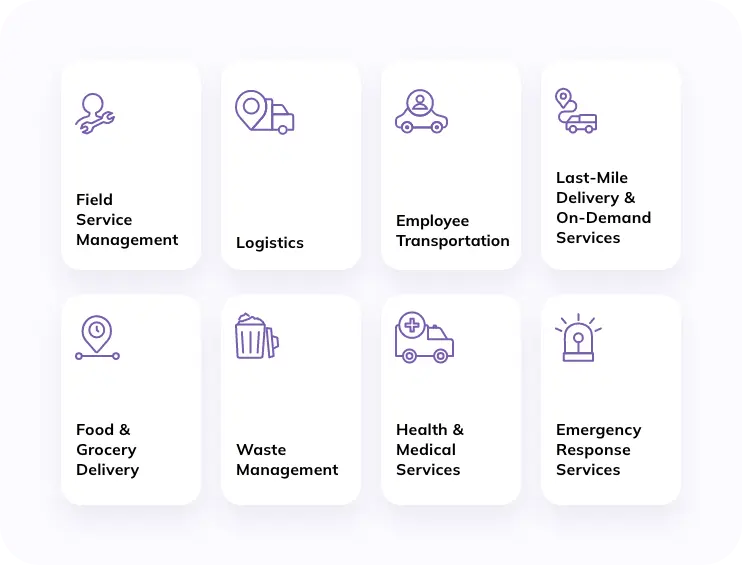
Field Service Management
In the field service industry, addressing complex multi-resource scheduling and dispatch challenges is essential. The 'skills' parameter becomes pivotal as it guarantees tasks are assigned to workers with the right expertise, such as technicians skilled in specific repairs. Additionally, the 'time window' constraint helps ensure timely service appointments and the 'priority' parameter enables differentiation between urgent repairs and routine maintenance, optimizing resource allocation.
NextBillion.ai’s Route Optimization API: A Game-Changer for Field Force Companies
Logistics
In the logistics sector, the 'capacity' attribute proves invaluable, allowing businesses to define diverse capacities for vehicles based on weight, volume and more. The 'pickup' and 'delivery' attributes streamline the handling of shipments across the supply chain. The 'maximum tasks' constraint ensures the efficient distribution of tasks among vehicles, maximizing fleet utilization. The ‘cost’ preference helps logistics companies cut down on expenses related to fuel, labor, and vehicle maintenance.
How to Implement Route Optimization API in Python
Employee Transportation
To enable safety and efficiency in employee transportation, the importance of optimizing pick-up and drop-off sequences cannot be overstated. Leveraging the 'relations' feature guarantees that the correct sequence of pick-up and drop-off is maintained. The 'time window' and ‘capacity ’constraints ensure vehicle utilization is maximized. Reducing the amount of time spent in vehicles is a critical factor in assessing a business's competitive advantage; the ‘max_time_in_vehicle’ allows you to configure the threshold for such tasks.
Last-Mile Delivery and On-Demand Services
In the last-mile or on-demand service industry, the 'travel cost' parameter is a critical optimization objective. By selecting the 'duration' objective, the solver can minimize the time taken for deliveries, ensuring swift last-mile services. Moreover, real-time traffic conditions play a vital role in route optimization. The 'traffic timestamp' and 'departure time' constraints leverage traffic data to guide the solver in calculating the fastest routes, ensuring prompt deliveries even in congested areas. The ‘depot’ feature can come in handy when fulfilling orders of multiple or single inventory types, serving orders within a specific area of a large area or facilitating reverse logistics scenarios.
Profitability of On-Demand Delivery: Understanding Unit Economics and the Role of Maps
Food and Grocery Delivery
In food and grocery delivery, freshness is key. By customizing travel costs between different delivery locations, businesses can influence the optimization algorithm to choose routes with lower distances to ensure that perishable items are delivered within their freshness windows. The 'relations' feature comes into play by configuring job or shipment sequences. This ensures that specific constraints, like grouping certain deliveries together for efficient route planning, are met. The 'custom cost matrix' feature is particularly useful. Additionally, the 'soft constraints' like 'maximum visit lateness' accommodate minor deviations from delivery time windows while maintaining service standards.
Xpress Global Systems(XGS) Cuts Costs by 35% with Route Optimization
Waste Management
Constraints like 'time window' are crucial to ensure waste pickup aligns with designated schedules, minimizing disruptions to residents and businesses. Additionally, the 'capacity' attribute comes into play as waste collection vehicles need to adhere to weight limits. The 'travel cost' objective, set to 'distance,' helps minimize fuel consumption and emissions. With the ‘incompatible_load_types’ constraint, the optimization engine ensures that vehicles containing certain types of cargo aren’t assigned tasks that involve incompatible workloads.
Health and Medical Services
The 'time window' constraint ensures that medical deliveries, patient transfers and other critical tasks are completed within designated time slots, optimizing patient care. The 'priority' parameter aids in differentiating between urgent medical supply deliveries and routine tasks, ensuring essential medical resources reach their destinations promptly. Moreover, the 'capacity' and ‘skill’ attributes ensure that medical vehicles and workers are appropriately equipped to handle different types of medical equipment and tasks.
Emergency Response Services
Tailoring the 'capacity' and ‘skill’ attributes ensures that emergency vehicles are equipped with the necessary resources to address a variety of critical situations. Meanwhile, leveraging the 'real-time traffic' feature allows routes to be dynamically adjusted based on live traffic conditions, enabling swift navigation through congested areas. Configuring the 'travel cost' objective to prioritize travel time minimization ensures that emergency vehicles can swiftly reach their destinations.
Mastering Route Optimization: The NextBillion.ai Way
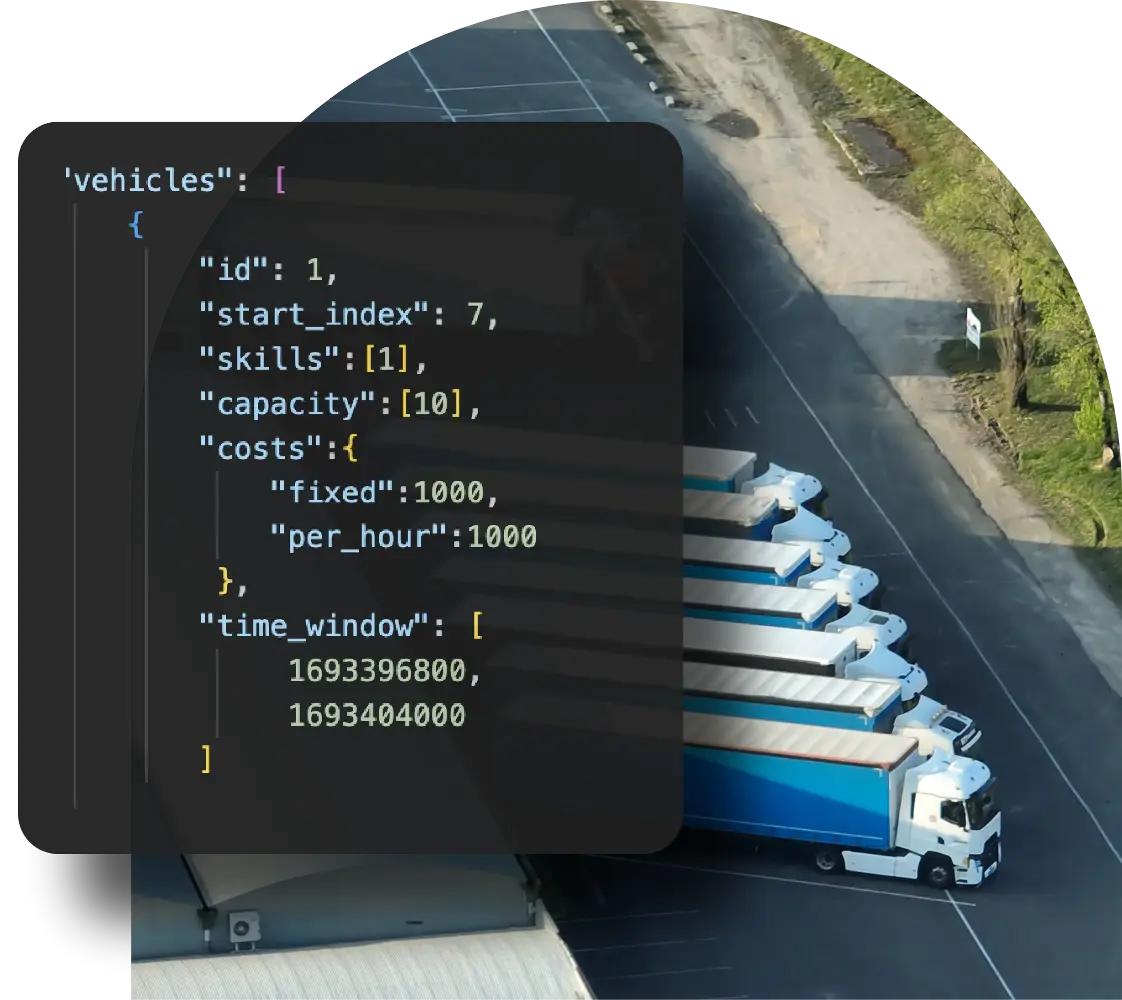
The optimization objectives, constraints and features covered here are just a glimpse of the comprehensive capabilities offered by NextBillion.ai Route Optimization API.
Our solution's adaptability extends beyond these examples, catering to diverse industry needs. Our dedicated customer support team and skilled solution engineers stand ready to create tailor-made route optimization solutions that align precisely with your business requirements. The possibilities are expansive, and customization is at the heart of our commitment to empowering businesses with optimized routes and enhanced operational efficiency.




